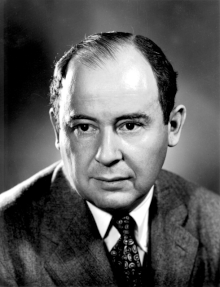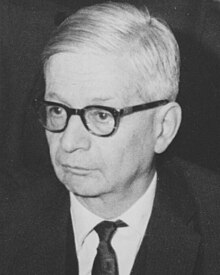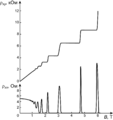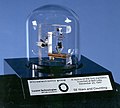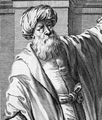Portal:Physics
Wikipedia portal for content related to Physics / From Wikipedia, the free encyclopedia
Portal maintenance status: (June 2018)
|
| Physics Portal Main Page | Physics Textbook | Wikiprojects and things to do |
The Physics Portal


Physics is the natural science of matter, involving the study of matter, its fundamental constituents, its motion and behavior through space and time, and the related entities of energy and force. Physics is one of the most fundamental scientific disciplines, with its main goal being to understand how the universe behaves. A scientist who specializes in the field of physics is called a physicist.
Physics is one of the oldest academic disciplines and, through its inclusion of astronomy, perhaps the oldest. Over much of the past two millennia, physics, chemistry, biology, and certain branches of mathematics were a part of natural philosophy, but during the Scientific Revolution in the 17th century these natural sciences emerged as unique research endeavors in their own right. Physics intersects with many interdisciplinary areas of research, such as biophysics and quantum chemistry, and the boundaries of physics are not rigidly defined. New ideas in physics often explain the fundamental mechanisms studied by other sciences and suggest new avenues of research in these and other academic disciplines such as mathematics and philosophy.
Advances in physics often enable new technologies. For example, advances in the understanding of electromagnetism, solid-state physics, and nuclear physics led directly to the development of new products that have dramatically transformed modern-day society, such as television, computers, domestic appliances, and nuclear weapons; advances in thermodynamics led to the development of industrialization; and advances in mechanics inspired the development of calculus. (Full article...)
 Featured article - show another
Featured article - show another

Radiocarbon dating (also referred to as carbon dating or carbon-14 dating) is a method for determining the age of an object containing organic material by using the properties of radiocarbon, a radioactive isotope of carbon.
The method was developed in the late 1940s at the University of Chicago by Willard Libby. It is based on the fact that radiocarbon (14C) is constantly being created in the Earth's atmosphere by the interaction of cosmic rays with atmospheric nitrogen. The resulting 14
C combines with atmospheric oxygen to form radioactive carbon dioxide, which is incorporated into plants by photosynthesis; animals then acquire 14
C by eating the plants. When the animal or plant dies, it stops exchanging carbon with its environment, and thereafter the amount of 14
C it contains begins to decrease as the 14
C undergoes radioactive decay. Measuring the proportion of 14
C in a sample from a dead plant or animal, such as a piece of wood or a fragment of bone, provides information that can be used to calculate when the animal or plant died. The older a sample is, the less 14
C there is to be detected, and because the half-life of 14
C (the period of time after which half of a given sample will have decayed) is about 5,730 years, the oldest dates that can be reliably measured by this process date to approximately 50,000 years ago (in this interval about 99.8% of the 14
C will have decayed), although special preparation methods occasionally make an accurate analysis of older samples possible. In 1960, Libby received the Nobel Prize in Chemistry for his work. (Full article...)
Did you know - show different entries
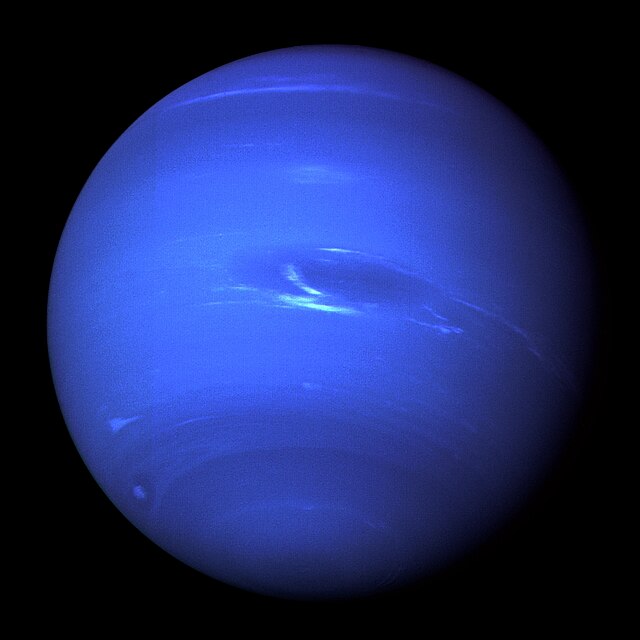
- ... that Aristotle's ideas of physics held that because an object could not move without an immediate source of energy, arrows created a vacuum behind them that pushed them through the air.
- ... that there are up to 6 candidates for the Theory of everything, minus String theory and Loop quantum gravity?
Selected image - show another

The Feynman Lectures on Physics is a 1964 physics textbook by Richard P. Feynman, Robert B. Leighton and Matthew Sands, based upon the lectures given by Feynman to undergraduate students at the California Institute of Technology (Caltech) in 1961–63.
It includes lectures on mathematics, electromagnetism, Newtonian physics, quantum physics, and the relation of physics to other sciences. Six readily accessible chapters were later compiled into a book entitled Six Easy Pieces: Essentials of Physics Explained by Its Most Brilliant Teacher, and six more in Six Not So Easy Pieces: Einstein's Relativity, Symmetry and Space-Time.
Related portals
 Good articles - load new batch
Good articles - load new batch
- Image 1Los Alamos badge photograph, 1944
Sir Joseph Rotblat KCMG CBE FRS (4 November 1908 – 31 August 2005) was a Polish and British physicist. During World War II he worked on Tube Alloys and the Manhattan Project, but left the Los Alamos Laboratory on grounds of conscience after it became clear to him in 1944 that Germany had ceased development of an atomic bomb.
His work on nuclear fallout was a major contribution toward the ratification of the 1963 Partial Nuclear Test Ban Treaty. A signatory of the 1955 Russell–Einstein Manifesto, he was secretary-general of the Pugwash Conferences on Science and World Affairs from their founding until 1973 and shared, with the Pugwash Conferences, the 1995 Nobel Peace Prize "for efforts to diminish the part played by nuclear arms in international affairs and, in the longer run, to eliminate such arms." (Full article...) - Image 2In 1850, Léon Foucault used a rotating mirror to perform a differential measurement of the speed of light in water versus its speed in air. In 1862, he used a similar apparatus to measure the speed of light in the air. (Full article...)
- Image 3
John Tucker "Chick" Hayward (15 November 1908 – 23 May 1999) was an American naval aviator during World War II. He helped develop one of the two atomic bombs that was dropped on Japan in the closing days of the war. Later, he was a pioneer in the development of nuclear propulsion, nuclear weapons, guidance systems for ground- and air-launched rockets, and underwater anti-submarine weapons. A former batboy for the New York Yankees, Hayward dropped out of high school and lied about his age to enlist in the United States Navy at age 16. He was subsequently admitted to the United States Naval Academy at Annapolis, from which he graduated 51st in his class of 1930. He volunteered for naval aviation.
During World War II, he served at the Naval Aircraft Factory in Philadelphia, where he was involved in an effort to improve aircraft instrumentation, notably the compass and altimeter. He attended the University of Pennsylvania's Moore School of Electrical Engineering, and studied nuclear physics. In June 1942, he assumed command of a new patrol bomber squadron, VB-106, equipped with PB4Y-1 Liberators, which he led in a daring raid on Wake Island, in the Solomon Islands campaign, and in the Southwest Pacific Area. Returning to the United States in 1944, he was posted to the Naval Ordnance Test Station at Inyokern, California, where he joined the Manhattan Project, participating in Project Camel, the development of the non-nuclear components of the Fat Man bomb, and in its drop testing. (Full article...) - Image 4
Eugene Paul Wigner (Hungarian: Wigner Jenő Pál, pronounced [ˈviɡnɛr ˈjɛnøː ˈpaːl]; November 17, 1902 – January 1, 1995) was a Hungarian-American theoretical physicist who also contributed to mathematical physics. He received the Nobel Prize in Physics in 1963 "for his contributions to the theory of the atomic nucleus and the elementary particles, particularly through the discovery and application of fundamental symmetry principles".
A graduate of the Technical University of Berlin, Wigner worked as an assistant to Karl Weissenberg and Richard Becker at the Kaiser Wilhelm Institute in Berlin, and David Hilbert at the University of Göttingen. Wigner and Hermann Weyl were responsible for introducing group theory into physics, particularly the theory of symmetry in physics. Along the way he performed ground-breaking work in pure mathematics, in which he authored a number of mathematical theorems. In particular, Wigner's theorem is a cornerstone in the mathematical formulation of quantum mechanics. He is also known for his research into the structure of the atomic nucleus. In 1930, Princeton University recruited Wigner, along with John von Neumann, and he moved to the United States, where he obtained citizenship in 1937. (Full article...) - Image 5
John von Neumann (/vɒn ˈnɔɪmən/ von NOY-mən; Hungarian: Neumann János Lajos [ˈnɒjmɒn ˈjaːnoʃ ˈlɒjoʃ]; December 28, 1903 – February 8, 1957) was a Hungarian and American mathematician, physicist, computer scientist, engineer and polymath. He had perhaps the widest coverage of any mathematician of his time, integrating pure and applied sciences and making major contributions to many fields, including mathematics, physics, economics, computing, and statistics. He was a pioneer in building the mathematical framework of quantum physics, in the development of functional analysis, and in game theory, introducing or codifying concepts including cellular automata, the universal constructor and the digital computer. His analysis of the structure of self-replication preceded the discovery of the structure of DNA.
During World War II, von Neumann worked on the Manhattan Project. He developed the mathematical models behind the explosive lenses used in the implosion-type nuclear weapon. Before and after the war, he consulted for many organizations including the Office of Scientific Research and Development, the Army's Ballistic Research Laboratory, the Armed Forces Special Weapons Project and the Oak Ridge National Laboratory. At the peak of his influence in the 1950s, he chaired a number of Defense Department committees including the Strategic Missile Evaluation Committee and the ICBM Scientific Advisory Committee. He was also a member of the influential Atomic Energy Commission in charge of all atomic energy development in the country. He played a key role alongside Bernard Schriever and Trevor Gardner in the design and development of the United States' first ICBM programs. At that time he was considered the nation's foremost expert on nuclear weaponry and the leading defense scientist at the U.S. Department of Defense. (Full article...) - Image 6
Sir Rudolf Ernst Peierls, CBE FRS (/ˈpaɪ.ərlz/; German: [ˈpaɪɐls]; 5 June 1907 – 19 September 1995) was a German-born British physicist who played a major role in Tube Alloys, Britain's nuclear weapon programme, as well as the subsequent Manhattan Project, the combined Allied nuclear bomb programme. His 1996 obituary in Physics Today described him as "a major player in the drama of the eruption of nuclear physics into world affairs".
Peierls studied physics at the University of Berlin, at the University of Munich under Arnold Sommerfeld, the University of Leipzig under Werner Heisenberg, and ETH Zurich under Wolfgang Pauli. After receiving his DPhil from Leipzig in 1929, he became an assistant to Pauli in Zurich. In 1932, he was awarded a Rockefeller Fellowship, which he used to study in Rome under Enrico Fermi, and then at the Cavendish Laboratory at the University of Cambridge under Ralph H. Fowler. Because of his Jewish background, he elected to not return home after Adolf Hitler's rise to power in 1933, but to remain in Britain, where he worked with Hans Bethe at the Victoria University of Manchester, then at the Mond Laboratory at Cambridge. In 1937, Mark Oliphant, the newly appointed Australian professor of physics at the University of Birmingham recruited him for a new chair there in applied mathematics. (Full article...) - Image 7
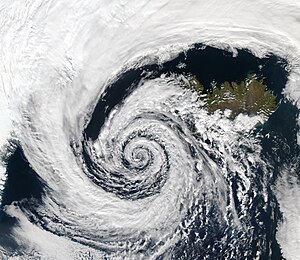
An extratropical cyclone near Iceland
In meteorology, a cyclone (/ˈsaɪ.kloʊn/) is a large air mass that rotates around a strong center of low atmospheric pressure, counterclockwise in the Northern Hemisphere and clockwise in the Southern Hemisphere as viewed from above (opposite to an anticyclone). Cyclones are characterized by inward-spiraling winds that rotate about a zone of low pressure. The largest low-pressure systems are polar vortices and extratropical cyclones of the largest scale (the synoptic scale). Warm-core cyclones such as tropical cyclones and subtropical cyclones also lie within the synoptic scale. Mesocyclones, tornadoes, and dust devils lie within the smaller mesoscale.
Upper level cyclones can exist without the presence of a surface low, and can pinch off from the base of the tropical upper tropospheric trough during the summer months in the Northern Hemisphere. Cyclones have also been seen on extraterrestrial planets, such as Mars, Jupiter, and Neptune. Cyclogenesis is the process of cyclone formation and intensification. Extratropical cyclones begin as waves in large regions of enhanced mid-latitude temperature contrasts called baroclinic zones. These zones contract and form weather fronts as the cyclonic circulation closes and intensifies. Later in their life cycle, extratropical cyclones occlude as cold air masses undercut the warmer air and become cold core systems. A cyclone's track is guided over the course of its 2 to 6 day life cycle by the steering flow of the subtropical jet stream. (Full article...) - Image 8
Robert Rathbun Wilson (March 4, 1914 – January 16, 2000) was an American physicist known for his work on the Manhattan Project during World War II, as a sculptor, and as an architect of the Fermi National Accelerator Laboratory (Fermilab), where he was the first director from 1967 to 1978.
A graduate of the University of California, Berkeley (BA and PhD), Wilson received his doctorate under the supervision of Ernest Lawrence for his work on the development of the cyclotron at the Berkeley Radiation Laboratory. He subsequently went to Princeton University to work with Henry DeWolf Smyth on electromagnetic separation of the isotopes of uranium. In 1943, Wilson and many of his colleagues joined the Manhattan Project's Los Alamos Laboratory, where Wilson became the head of its Cyclotron Group (R-1), and later its Research (R) Division. (Full article...) - Image 9

Val Logsdon Fitch (March 10, 1923 – February 5, 2015) was an American nuclear physicist who, with co-researcher James Cronin, was awarded the 1980 Nobel Prize in Physics for a 1964 experiment using the Alternating Gradient Synchrotron at Brookhaven National Laboratory that proved that certain subatomic reactions do not adhere to fundamental symmetry principles. Specifically, they proved, by examining the decay of K-mesons, that a reaction run in reverse does not retrace the path of the original reaction, which showed that the reactions of subatomic particles are not indifferent to time. Thus the phenomenon of CP violation was discovered. This demolished the faith that physicists had that natural laws were governed by symmetry.
Born on a cattle ranch near Merriman, Nebraska, Fitch was drafted into the U.S. Army during World War II, and worked on the Manhattan Project at the Los Alamos Laboratory in New Mexico. He later graduated from McGill University, and completed his PhD in physics in 1954 at Columbia University. He was a member of the faculty at Princeton University from 1954 until his retirement in 2005. (Full article...) - Image 10
James Clerk Maxwell FRSE FRS (13 June 1831 – 5 November 1879) was a Scottish physicist with broad interests who was responsible for the classical theory of electromagnetic radiation, which was the first theory to describe electricity, magnetism and light as different manifestations of the same phenomenon. Maxwell's equations for electromagnetism have been called the "second great unification in physics" where the first one had been realised by Isaac Newton.
With the publication of "A Dynamical Theory of the Electromagnetic Field" in 1865, Maxwell demonstrated that electric and magnetic fields travel through space as waves moving at the speed of light. He proposed that light is an undulation in the same medium that is the cause of electric and magnetic phenomena. The unification of light and electrical phenomena led to his prediction of the existence of radio waves. Maxwell is also regarded as a founder of the modern field of electrical engineering. (Full article...) - Image 11

Styrofoam peanuts clinging to a cat's fur due to static electricity.
The triboelectric effect (also known as triboelectricity, triboelectric charging, triboelectrification, or tribocharging) describes electric charge transfer between two objects when they contact or slide against each other. It can occur with different materials, such as the sole of a shoe on a carpet, or between two pieces of the same material. It is ubiquitous, and occurs with differing amounts of charge transfer (tribocharge) for all solid materials. There is evidence that tribocharging can occur between combinations of solids, liquids and gases, for instance liquid flowing in a solid tube or an aircraft flying through air.
Often static electricity is a consequence of the triboelectric effect when the charge stays on one or both of the objects and is not conducted away. The term triboelectricity has been used to refer to the field of study or the general phenomenon of the triboelectric effect, or to the static electricity that results from it. When there is no sliding, tribocharging is sometimes called contact electrification, and any static electricity generated is sometimes called contact electricity. The terms are often used interchangeably, and may be confused. (Full article...) - Image 12

The Type Ib supernova SN 2008D in galaxy NGC 2770, shown in X-ray (left) and visible light (right), at the corresponding positions of the images. (NASA image.)
Type Ib and Type Ic supernovae are categories of supernovae that are caused by the stellar core collapse of massive stars. These stars have shed or been stripped of their outer envelope of hydrogen, and, when compared to the spectrum of Type Ia supernovae, they lack the absorption line of silicon. Compared to Type Ib, Type Ic supernovae are hypothesized to have lost more of their initial envelope, including most of their helium. The two types are usually referred to as stripped core-collapse supernovae. (Full article...) - Image 13
Leona Harriet Woods (August 9, 1919 – November 10, 1986), later known as Leona Woods Marshall and Leona Woods Marshall Libby, was an American physicist who helped build the first nuclear reactor and the first atomic bomb.
At age 23, she was the youngest and only female member of the team which built and experimented with the world's first nuclear reactor (then called a pile), Chicago Pile-1, in a project led by her mentor Enrico Fermi. In particular, Woods was instrumental in the construction and then utilization of geiger counters for analysis during experimentation. She was the only woman present when the reactor went critical. She worked with Fermi on the Manhattan Project, and she subsequently helped evaluate the cross section of xenon, which had poisoned the first Hanford production reactor when it began operation. (Full article...) - Image 14

The Wow! signal represented as "6EQUJ5". The original printout with Ehman's handwritten exclamation is preserved by Ohio History Connection.
The Wow! signal was a strong narrowband radio signal detected on August 15, 1977, by Ohio State University's Big Ear radio telescope in the United States, then used to support the search for extraterrestrial intelligence. The signal appeared to come from the direction of the constellation Sagittarius and bore expected hallmarks of extraterrestrial origin.
Astronomer Jerry R. Ehman discovered the anomaly a few days later while reviewing the recorded data. He was so impressed by the result that he circled on the computer printout the reading of the signal's intensity, "6EQUJ5", and wrote the comment "Wow!" beside it, leading to the event's widely used name. (Full article...) - Image 15
Henri Coutard (27 August 1876 – 16 March 1950) was a French radiation therapist. He is known for his studies of radiation therapy for the treatment of laryngeal cancer and the development of the "protracted-fractional method" of radiation dosing.
Born in Marolles-les-Braults in the French department of Sarthe, Coutard attended medical school at University of Paris and graduated in 1902. He served in the French Army and lived for several years in the Jura Mountains before returning to Paris to study the medical applications of radium. During World War I, he worked in one of the radiological ambulance units overseen by the Polish-French physicist and chemist Marie Curie. He became the chief of the X-ray department at the Radium Institute of the University of Paris in 1919, working closely with Claudius Regaud and other scientists. Coutard's early work demonstrating the efficacy of radiating patients with laryngeal cancer led to the adoption of radiation therapy as a primary course of cancer treatment. The protracted-fractional method consisted of long durations of radiation applied over several weeks. (Full article...)
April anniversaries
- 1 April 1997 – Comet Hale-Bopp at perihelion
- 12 April 1633 – Galileo Galilei's trial starts
- 15 April 1707 – Leonhard Euler's birthday
- 18 April 1955 – Albert Einstein's death
- 22 April 1904 – J. Robert Oppenheimer's birthday
- 23 April 1858 – Max Planck's birthday
- 24 April 1990 – Hubble Space Telescope launched
- 25 April 1990 – Hubble Space Telescope deployed from the shuttle Discovery
- 30 April 1777 – Carl Friedrich Gauss's birthday
General images
- Image 2Einstein proposed that gravitation is a result of masses (or their equivalent energies) curving ("bending") the spacetime in which they exist, altering the paths they follow within it. (from History of physics)
- Image 5The quantum Hall effect: Components of the Hall resistivity as a function of the external magnetic field (from Condensed matter physics)
- Image 7Galileo Galilei, early proponent of the modern scientific worldview and method
(1564–1642) (from History of physics) - Image 11The first Bose–Einstein condensate observed in a gas of ultracold rubidium atoms. The blue and white areas represent higher density. (from Condensed matter physics)
- Image 12Computer simulation of nanogears made of fullerene molecules. It is hoped that advances in nanoscience will lead to machines working on the molecular scale. (from Condensed matter physics)
- Image 17Chien-Shiung Wu worked on parity violation in 1956 and announced her results in January 1957. (from History of physics)
- Image 19Star maps by the 11th-century Chinese polymath Su Song are the oldest known woodblock-printed star maps to have survived to the present day. This example, dated 1092, employs the cylindrical equirectangular projection. (from History of physics)
- Image 21A Feynman diagram representing (left to right) the production of a photon (blue sine wave) from the annihilation of an electron and its complementary antiparticle, the positron. The photon becomes a quark–antiquark pair and a gluon (green spiral) is released. (from History of physics)
- Image 22Marie Skłodowska-Curie
(1867–1934) She was awarded two Nobel prizes, Physics (1903) and Chemistry (1911) (from History of physics) - Image 24Classical physics (Rayleigh–Jeans law, black line) failed to explain black-body radiation – the so-called ultraviolet catastrophe. The quantum description (Planck's law, colored lines) is said to be modern physics. (from Modern physics)
- Image 25Classical physics is usually concerned with everyday conditions: speeds are much lower than the speed of light, sizes are much greater than that of atoms, yet very small in astronomical terms. Modern physics, however, is concerned with high velocities, small distances, and very large energies. (from Modern physics)
- Image 26One possible signature of a Higgs boson from a simulated proton–proton collision. It decays almost immediately into two jets of hadrons and two electrons, visible as lines. (from History of physics)
- Image 28The Polish astronomer Nicolaus Copernicus (1473–1543) is remembered for his development of a heliocentric model of the Solar System. (from History of physics)
- Image 31Heike Kamerlingh Onnes and Johannes van der Waals with the helium liquefactor at Leiden in 1908 (from Condensed matter physics)
- Image 32A magnet levitating above a high-temperature superconductor. Today some physicists are working to understand high-temperature superconductivity using the AdS/CFT correspondence. (from Condensed matter physics)
- Image 33The ancient Greek mathematician Archimedes, famous for his ideas regarding fluid mechanics and buoyancy. (from History of physics)
- Image 34J. J. Thomson (1856–1940) discovered the electron and isotopy and also invented the mass spectrometer. He was awarded the Nobel Prize in Physics in 1906. (from History of physics)
- Image 35The Hindu-Arabic numeral system. The inscriptions on the edicts of Ashoka (3rd century BCE) display this number system being used by the Imperial Mauryas. (from History of physics)
- Image 40A composite montage comparing Jupiter (lefthand side) and its four Galilean moons (top to bottom: Io, Europa, Ganymede, Callisto). (from History of physics)
Categories

Fundamentals: Concepts in physics | Constants | Physical quantities | Units of measure | Mass | Length | Time | Space | Energy | Matter | Force | Gravity | Electricity | Magnetism | Waves
Basic physics: Mechanics | Electromagnetism | Statistical mechanics | Thermodynamics | Quantum mechanics | Theory of relativity | Optics | Acoustics
Specific fields: Acoustics | Astrophysics | Atomic physics | Molecular physics | Optical physics | Computational physics | Condensed matter physics | Nuclear physics | Particle physics | Plasma physics
Tools: Detectors | Interferometry | Measurement | Radiometry | Spectroscopy | Transducers
Background: Physicists | History of physics | Philosophy of physics | Physics education | Physics journals | Physics organizations
Other: Physics in fiction | Physics lists | Physics software | Physics stubs
Physics topics
Classical physics traditionally includes the fields of mechanics, optics, electricity, magnetism, acoustics and thermodynamics. The term Modern physics is normally used for fields which rely heavily on quantum theory, including quantum mechanics, atomic physics, nuclear physics, particle physics and condensed matter physics. General and special relativity are usually considered to be part of modern physics as well.
More recognized content
Associated Wikimedia
The following Wikimedia Foundation sister projects provide more on this subject:
-
Commons
Free media repository -
Wikibooks
Free textbooks and manuals -
Wikidata
Free knowledge base -
Wikinews
Free-content news -
Wikiquote
Collection of quotations -
Wikisource
Free-content library -
Wikiversity
Free learning tools -
Wikivoyage
Free travel guide -
Wiktionary
Dictionary and thesaurus




